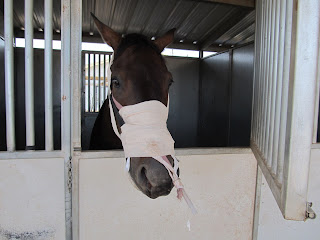 |
| Me and the Wonder Horse in a saber charge. |
One of the most thrilling and dangerous aspects of being a cavalry trooper is performing open-field charges on the parade ground. It is there that people find out if they really want to be a trooper.
The horses know what happens on the parade ground. They are relatively calm on the field at first as most of what they do there involves standing still for an hour and listening to military marching music. However, once we begin to set up for the charge, they experience a huge adrenalin rush as they know they are about to do what all horses love the most--run across flat, grassy ground as fast as their legs will carry them. It is what they were made for.
"He paws fiercely, rejoicing in his strength, and charges into the fray."
Most of our horses do this well and although they may gallop up the field as fast as they can, they will all come to a stop at the end of the charge. They know when it is time to stop. All of them, that is, except Apache the Wonder Horse.
"In frenzied excitement he eats up the ground;"
Apache is hot. His Arabian blood burns through his veins like molten lava. The quarter horse blood mixed into his makeup offers no cooling effects. He is a furnace of unquenchable fire and any affection he may hold for me evaporates in a mist of sprayed sweat from his heaving flanks when the trumpet sounds.
"...he cannot stand still when the trumpet sounds."
I have ridden him in maybe four public ceremonies involving a charge over the years. It is not that he can't do it, it is just a gamble. A gamble with my life. It is like driving a race car with faulty brakes at full speed directly at a tree wondering if you will be able to stop.
Yesterday, we practiced charges with the new students. We set up a canopy on the side of the field and a boom-box with marshal music playing to simulate a ceremonial crowd and band. As we went through the sequence of events of a typical ceremony, Apache pawed the ground with the same impatience and excitement of his ancient ancestors, referred to thousands of years ago in the above quotes from the Book of Job.
When we tried to teach the students how to charge, we set up the skirmish line and forced the horses to alternatively walk and trot while staying on line. The idea behind this technique is to teach both horses and students to remain in control during the charge instead of launching into an out-of-control horse race.
Apache does not walk or trot in this situation, he basically gallops in place. He speeds up or slows down based on the cues I give with the reins, but his legs do not stop galloping. It is like holding the brakes on a car while spinning the tires. He is desperate to do what God designed him to do. It is only his respect for me that keeps him tethered.
Finally, his frustration overwhelms him and he pops up and throws his head back into my face. I am fortunate that I have my head turned to the right, but he catches me full in the left side of my head. Somehow, I managed to stay in the saddle. Woozy, I guide him to the side of the field and dismount by the people on the ground near the canopy who are watching all this. Unsure of my condition, I dismount and shake my head a few times to try and reseat my rattled brain. I am pleased to note that I can still stand. I figure if I can stand, I can ride, so I mount up again.
The other riders are at the end of the field looking at me and wondering what I am doing. I spur Apache into a gallop and we rejoin the group without incident. Because we are not in a charge, Apache is under control. It is all about the context of the situation. We try the charge again, but this time I'm careful not to put my head in a position where I can get clobbered again. We move up the field going from walk, to trot, to gallop, but Apache is not able to reach me with his head this time and I'm able to complete the lesson without being knocked out.
At that point pain and exhaustion compel me to step aside during the next charge. My training objective for the Wonder Horse is accomplished and there is no point in pushing Apache further as eventually he will explode. I know this from experience. The rest of the class attempts another charge and I am pleased to see the students are able to maintain control.
Today I look like Rocky Balboa after a fight with Apollo Creed. I have abrasions on the left side of my face and my eye is swollen, but fortunately the pain has mostly subsided. I'm glad now that I didn't ride Apache during last month's ceremonies. He can do the ceremonies, but not particularly well and not particularly safely. Eventually, his blood will cool and he will be a good ceremony horse. Maybe in about ten years.




























